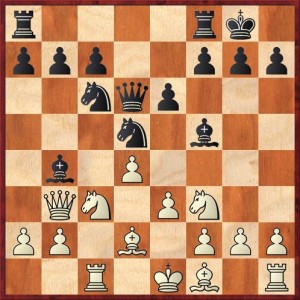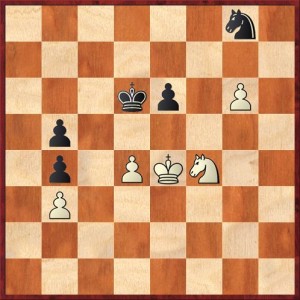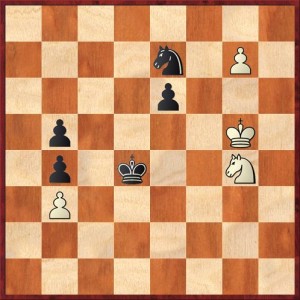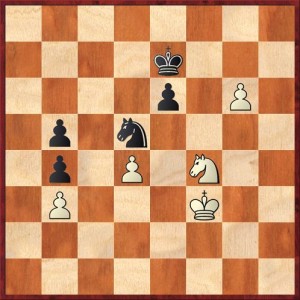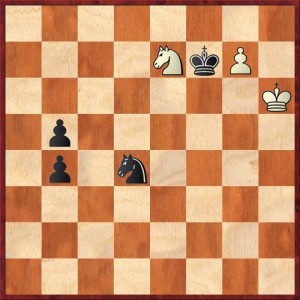Right after I posted Mike Splane’s game with Igor Ivanov I was going to post my own, but then I got too busy. But here it is — better late than never!
I played against Ivanov in the 2002 North American Open, a tournament that went very well for me. We played one of my favorite opening lines, the Marshall Variation of the Queen’s Gambit Declined, and Ivanov handled it surprisingly listlessly. I thought that I got a really good position out of the opening. Judge for yourself:
Ivanov, Igor — Mackenzie, Dana
1. d4 Nf6 2. c4 d5 3. cd Nxd5 4. Nf3 Bf5 5. Qb3 e6!
I am a bit skeptical of 5. Qb3, a move whose main purpose seems to be to take the b7 pawn. But in my opinion Black has nothing to fear from 6. Qxb7 here. Ivanov evidently felt the same way. But if White isn’t going to take on b7, then why move the queen out?
6. Bg5 Bb4+ 7. Nc3 Qd6 8. Bd2 O-O 9. Rc1 Nc6 10. e3 …
FEN: r4rk1/ppp2ppp/2nqp3/3n1b2/1b1P4/1QN1PN2/PP1B1PPP/2R1KB1R b K – 0 10
This is a good position to talk about. The opening has gone as well for Black as he could possibly hope. Black’s development is complete and White’s isn’t; Black’s pieces are posted more aggressively than White’s. How could Black possibly be worse?
However, on a closer look it’s not so simple. Black’s aggressively posted pieces are also in places where White can easily chase them away, with moves like a3 or e4. Once they retreat, some of the latent weaknesses (b7 and c7) will be exposed.
The computer says that my next move is okay but I feel as if it’s my first step in the wrong direction. I should be absolutely methodical here and “invite all my pieces to the party” with 10. … Rfd8 (or Rad8). If White plays a normal developing move like 11. Be2, then 11. … e5! is already a threat. Or if 11. Bb5 now I think that 11. … Na5 can be played under slightly better circumstances than in the actual game.
Instead I played
10. … Na5?! 11. Qd1 Nxc3 12. Bxc3 c5?
Obviously no good, but it’s an example of the psychology of playing against a grandmaster. The computer says that I should simply play 12. … Bxc3+ 13. Rxc3 Nc6 with an equal game. But I felt as if the initiative was slipping away and I wanted to put pressure on White’s center. Of course the problem is that White can double Black’s b-pawns and then White will be “effectively” a pawn up.
However, I convinced myself that this would not be the end of the world. A comparison would be the Exchange Variation of the Ruy Lopez, where Black’s 4-3 pawn advantage on the queenside is neutralized by the fact that they are doubled, while White is “effectively” a pawn up on the kingside. However, it’s important to realize that pawn structure isn’t everything — piece position matters too, and “before the endgame the gods have placed the middlegame.”
That being said, in this game I never did succeed in creating the desired counterplay with my pieces, and many moves later we did reach an endgame where White was “essentially” a pawn up.
13. Bxb4 cb
… and let’s now fast forward to move 47.
FEN: 6n1/8/3kp1P1/1p6/1p1PKN2/1P6/8/8 w – – 0 47
The move Ivanov made here surprised me during the game. I thought that 47. Nh5 was a simple win. Black can’t afford to move his king and let White’s king occupy e5, so all I’m left with are knight moves. Let’s say I play 47. … Nh6 48. g7 Ng8 49. Kf4 Kd5 50. Kg5 Kxd5 51. Nf6 Ne7 52. Ng4!
FEN: 6n1/8/3kp1P1/1p6/1p1PKN2/1P6/8/8 w – – 0 47
White will play 53. Kf6, chasing the knight to g8, and then play 54. Kf7. Note that White’s knight covers the flight square on h6. If Black defends the knight with 52. … Kd5 53. Kf6 Kd6, then White zugzwangs him with 54. Kf7! Kd7 55. Ne5+ Kd6 56. Kf8! [NB: Mistake fixed 2 hours after original post. In the original post I forgot the intervening 55. Ne5+ Kd6.]
So why didn’t Ivanov play this way? In my opinion, it’s because he wanted to win without taking any risks. Giving up the d-pawn was, after all, a bit of a risk, and if you don’t calculate it correctly Black could draw or even win. For example, 56. Ng6?? would be a terrible mistake because of 56. … Nf5! Black succeeds in sacrificing his knight for the g-pawn, and after that only Black can win.
So, backing up to diagram 2, the move he played was 47. Nd3!? Nf6+ 48. Ke3 Nd5+ 49. Kf3 Ke7 50. Nf4 (diagram).
FEN: 8/4k3/4p1P1/1p1n4/1p1P1N2/1P3K2/8/8 b – – 0 50
Now I played a terrible, irrelevant move, which justified Ivanov’s whole strategy. Why take risks when your opponent will fall into the first obvious trap you set for him? So I played 50. … Nc3?? 51. g7! Kf7 52. Nxe6! and resigned.
The question is, if I had played the forced 50. … Nf6, how does White make progress? I don’t think that he gets anywhere with 51. Ke3 Ng4+ 52. Ke4 Kf6 53. g7 Nh6. Black just keeps his king on f6 as long as possible.
Therefore, I think the only way for White to win is to do exactly what Ivanov didn’t want to do: take risks. I spent a couple hours last week on this endgame, and found the following amazing win for White:
50. … Nf6 51. Kg3! Ne4+ 52. Kg4 Nd2 53. Kh5 Nxb3 54. d5!! (threatening 55. d6+, when Black can’t stop the separated passed pawns) 54. … ed 55. Nxd5+. The knight now controls two key squares — f6 and e7. 55. … Kf8 56. Kh7 Nd4 57. g7+ Kf7 58. Ne7!! This awesome move does everything: it threatens g8, deflects the king, and defends the f5 square.
What can we learn from this?
1) The evaluation of knight and pawn endgames is a lot like the evaluation of king and pawn endgames. If we took the knights off, we would expect White to win easily because of his “extra” pawn. Here, too, the position ultimately seems to be won for White. However…
2) The tactics involved with knight and pawn endgames are much more complicated than king and pawn endgames. New themes include deflection sacrifices (like we saw in the game), forks, and for the defender, sacrifices to reach a position with insufficient mating material. For the attacker, simple threats to trade knights into a won K+P endgame can also be a strong weapon.
3) Therefore it is imperative for both players to be alert. I lost this game because I already felt beaten by move 50, and I was just playing out the string. So I wasn’t alert.
4) Grandmasters will exhaust the possibilities for winning a game without risk before they plunge into a risky variation that’s hard to calculate all the way.
5) When playing a grandmaster, resist defeatist thinking, the feeling that “he knows better than me.” That hurt me both in the opening and in the endgame.
